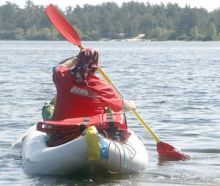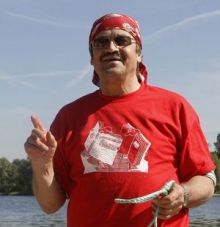Canoe, camera, voice recorder and tent are the most important attributes of the new research route of Mykola Khriienko. On September 11 special correspondent for The Day set off on a 20-day expedition along the Dnipro River. He planned his trip to mark the 16th anniversary of the first publication of the newspaper.
Khriienko plans to canoe 364 kilometers down from the Kyiv Reservoir dam to the dam of Kremenchuk Reservoir near Svitlovodsk to investigate the situation with seizure of Dnipro bank line water protection zone, as well as the life of those who fully depend on this river.
In fact, life of the journalist himself is closely connected with Dnipro. Khriienko was born in the village of Novo-Lypove in Svitlovodsk raion, which today is on the bottom of Kremenchuk Reservoir. As a reporter for the newspaper Soviet Ukraine, he twice made canoe trips in 1978 and in 1979 as part of the student environmental expedition. This year’s route from Kyiv to Svitlovodsk is his third canoe trip and 25th trip in general. He took only five of all the trips as a part of some group. “I am a single traveler,” Khriienko described himself.
Single trips do not only imply certain freedom in actions, but also mean a great responsibility, especially for gathering everything you might need during a trip. On the sandy banks of the Dnipro near Vyshhorod canoe Robinson (Khriienko came up with this name for the boat on his own; he said he got this idea after he once looked at a large home globe and realized that all the terrestrial land of the planet is islands in its essence) is all ready for the trip. Equipment and food, all packed in sealed containers, is all there too. “If the canoe would be turned upside down by a wave nothing will soak or get lost because everything is tied to the boat with ropes.
“Then, with flippers and waistcoat on, I will push the canoe to the shore,” said the journalist. He also added that so far there are no such worries. The probability of large waves and unfavorable winds will increase once he reaches the Kremenchuk Reservoir, which is about 30 kilometers wide. However, some kayakers have already completed this route. If it would become impossible to continue the trip along the Dnipro, Khriienko will continue the expedition on foot. Even though canoe is a rather vulnerable means of transport, it is almost irreplaceable in this expedition because it is impossible to assess the level of development of the Dnipro River bank line from the land.
Khriienko always prepares for each expedition thoroughly. He says that the main thing for him in his trips is to complete the route. Gathering information is on the second place, and the third is safety. The most important key to success is the absence of fear.
“It is important not to be afraid, because fear paralyzes and prevents you from adequate assessing the situation. When during the project ‘Ukrainians beyond the Urals’ I faced a dilemma: I either had to interrupt the route or go for 530 kilometers over the mountains on foot. The whole day I pondered the situation and tried to rationally estimate the chances of success. Eventually, I decided to go on, but, if you realize that your chances are less than 50 percent you should not be afraid to retreat, at least, temporarily. Because the most important thing still remains the completion of the route. Road is always a serious and ruthless enemy. Therefore, in any trip physical shape means a lot. And above all is the interest and love for traveling. In my trips I managed to to combine things that do not usually go together: tourism, sport, and journalism. These are the three restive horses but I cope with them,” said Khriienko.
In addition to the ecological orientation, the important role in planning the route was played by social and historical factor. According to the journalist, he plans to pay the special attention to the grave of Taras Shevchenko, the spot on the Chernecha Hill where in 1978 Oleksa Hirnyk burned himself alive, and also the grave of Vasyl Symonenko. Among the other stops of the trip are: eco settlements in a village of Romashky near Khodorov, Trakhtemyrivsky peninsula and Cossack cemetery, construction site of the Kaniv Pumped Storage Plant and Chyhyryn Nuclear Power Plant. “The final stop – Svitlovodsk, has a very important meaning for me because my parents were buried in Svitlovodsk raion,” told Khriienko.
Khriienko’s wife Tamara, his younger son Serhii, and grandson Martyn came to say good bye to him. Martyn by tradition helped his grandfather throw the anchor into the water before the start. Mrs. Khriienko told The Day’s journalist after her husband paddled from the coast: “Every time when he sets off on a new trip I worry and pray for him – I have been doing so for 40 years now.”









